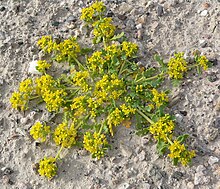Lepidium
| Lepidium | |
|---|---|
 | |
| Lepidium flavum | |
| Scientific classification | |
| Kingdom: | Plantae |
| Clade: | Tracheophytes |
| Clade: | Angiosperms |
| Clade: | Eudicots |
| Clade: | Rosids |
| Order: | Brassicales |
| Family: | Brassicaceae |
| Genus: | Lepidium L. |
| Species | |
| about 175-220, see text | |
Lepidium is a genus of plants in the mustard/cabbage family, Brassicaceae. The genus is widely distributed in the Americas, Africa, Asia, Europe, and Australia.[1] It includes familiar species such as garden cress, maca, and dittander. General common names include peppercress, peppergrass, pepperweed, and pepperwort. Some species form tumbleweeds.[2] The genus name Lepidium is a Greek word meaning 'small scale', which is thought to be derived from a folk medicine usage of the plant to treat leprosy, which cause small scales on the skin. Another meaning is related to the small scale-like fruit.[3]
Diversity[edit]

There are about 175[4] to 220[1] species in the genus.[3] 10 species are found in California.[3]
Species include:
- Lepidium africanum
- Lepidium amelum
- Lepidium armoracia Fisch. & C.A. Mey. 1843
- Lepidium apetalum Willd. – du xing cai (Pinyin, China)[5]
- Lepidium arbuscula
- Lepidium banksii
- Lepidium barnebyanum
- Lepidium biplicatum
- Lepidium bonariense – peppercress
- Lepidium campestre – field pepperwort, field cress
- Lepidium catapycnon
- Lepidium coronopus – swine cress
- Lepidium davisii – Davis' peppergrass[6]
- Lepidium densiflorum – common pepperweed
- Lepidium desvauxii – bushy peppercress
- Lepidium dictyotum
- Lepidium didymum
- Lepidium draba – hoary cress
- Lepidium drummondii
- Lepidium echinatum
- Lepidium ecuadoriense
- Lepidium englerianum
- Lepidium fasciculatum – bundled peppercress
- Lepidium flavum
- Lepidium flexicaule
- Lepidium foliosum – leafy peppercress
- Lepidium fremontii – desert pepperweed
- Lepidium genistoides
- Lepidium ginninderrense
- Lepidium graminifolium
- Lepidium howei-insulae – mustard & cress
- Lepidium hypenantion
- Lepidium hyssopifolium
- Lepidium heterophyllum – Smith's pepperwort, Smith's cress
- Lepidium jaredii – Jared's pepperweed
- Lepidium lasiocarpum
- Lepidium latifolium – pepperweed, dittander
- Lepidium latipes
- Lepidium lyratogynum
- Lepidium merrallii
- Lepidium meyenii (syn. L. peruvianum) – maca
- Lepidium monoplocoides – winged peppercress
- Lepidium montanum – western pepperweed, mountain pepperweed
- Lepidium nanum – dwarf pepperweed
- Lepidium nesophilum
- Lepidium nitidum – shining pepperweed
- Lepidium oblongum
- Lepidium oleraceum – Cook's scurvy grass (near extinct)
- Lepidium oxycarpum – forked pepperweed
- Lepidium oxytrichum
- Lepidium papilliferum – slickspot peppergrass
- Lepidium papillosum – warty peppercress
- Lepidium pedicellosum
- Lepidium peregrinum
- Lepidium perfoliatum
- Lepidium peruvianum
- Lepidium phlebopetalum
- Lepidium pholidogynum
- Lepidium pinnatifidum
- Lepidium platypetalum – slender peppercress
- Lepidium pseudohyssopifolium
- Lepidium pseudoruderale
- Lepidium pseudotasmanicum
- Lepidium puberulum
- Lepidium quitense
- Lepidium rotundum – veined peppercress
- Lepidium ruderale – narrow-leaved pepperwort
- Lepidium sagittulatum
- Lepidium sativum – garden cress
- Lepidium scandens
- Lepidium squamatum
- Lepidium strictum
- Lepidium thurberi – Thurber's peppergrass, Thurber's pepperweed
- Lepidium virginicum – Virginia peppercress
- Lepidium xylodes
Notes[edit]
- ^ a b Lepidium. Flora of North America.
- ^ Faulkner, H. W. (1917). The Mysteries of the Flowers. Frederick A. Stokes company. p. 238. page 210
- ^ a b c Sia Morhardt and Emil Morhardt California Desert Flowers: An Introduction to Families, Genera, and Species, p. 101, at Google Books
- ^ Mummenhoff, K., et al. (2001). Chloroplast DNA phylogeny and biogeography of Lepidium (Brassicaceae). American Journal of Botany 88(11), 2051-63.
- ^ Tropicos.org. Missouri Botanical Garden. 20 Dec 2011
- ^ Hagwood, Sheri. "Sensitive Plants of the JRA" (PDF). Idaho BLM. Archived from the original (PDF) on 3 May 2014. Retrieved 2 May 2014.
References[edit]
- Everitt, J.H.; Lonard, R.L.; Little, C.R. (2007). Weeds in South Texas and Northern Mexico. Lubbock: Texas Tech University Press. ISBN 0-89672-614-2
- "Lepidium". Australian Plant Name Index (APNI), IBIS database. Centre for Plant Biodiversity Research, Australian Government, Canberra. Retrieved 2008-02-28.
External links[edit]
- "Inland Lepidium recovery plan 2000-2010" (PDF). Department of Conservation, Wellington, New Zealand. 2000. Retrieved 2007-10-04.
- D.A. Norton; P.J. de Lange (1999). "Coastal Cresses (Nau) Recovery Plan" (PDF). Department of Conservation, Wellington, New Zealand. Retrieved 2007-04-19.
- Species Profile: Hairy Whitetop (Lepidium appelianum). National Invasive Species Information Center, United States National Agricultural Library.


No comments:
Post a Comment